Stephanie A. Mann's Blog, page 245
February 22, 2014
Will Ye No Come Again? A Portrait of Bonnie Prince Charlie
From
The Guardian
:
A genuine and acceptably bonny portrait of Bonnie Prince Charlie has been rediscovered, by the remorseful art historian who broke hearts in the Scottish souvenir industry by debunking the best-known portrait of the national hero, immortalised on countless tins of shortbread.
The long-lost portrait of the pink-cheeked prince was painted in Edinburgh in 1745 by one of Scotland's most renowned artists, Allan Ramsay, in the year the Young Pretender, grandson of the deposed Stuart king James II, launched a doomed invasion of England in an attempt to restore his family to the throne. It is the only known portrait of the prince made in Britain: the butchery of the battle of Culloden ended the Jacobite rebellion, Charles spent the rest of his life in exile, died in 1788 and was buried in Rome.
"Such a great image," Bendor Grosvenor said fondly of his discovery, which he tracked down from an old photograph to Gosford House, the family home of the Earls of Wemyss, just outside Edinburgh. "It gets the confidence of a man who wanted to invade England at the age of 24."
You may see the portrait at The Guardian site.
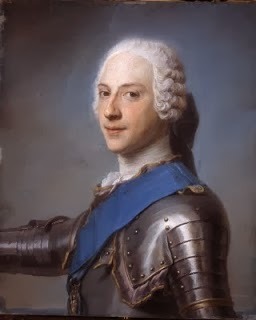 When Bendor Grosvener opined that a famous portrait of Bonnie Prince Charlie (seen at right) was really of his brother Henry Benedict, later Cardinal, Stuart, he really upset the apple cart, as this BBC article demonstrates:
When Bendor Grosvener opined that a famous portrait of Bonnie Prince Charlie (seen at right) was really of his brother Henry Benedict, later Cardinal, Stuart, he really upset the apple cart, as this BBC article demonstrates:
Now a leading expert believes the pastel might be Prince Henry Benedict instead of Charles Edward Stuart.
The gallery said it was not uncommon for re-attributions to be made.
It follows a two-year row over the identity of the man in the painting since London art dealer Bendor Grosvenor claimed it was not Bonnie Prince Charlie.
At first the gallery dismissed the claim citing expert on Jacobite portraiture, Dr Edward Corp of the University of Toulouse, France, in its defence.
However, Dr Corp has now changed his opinion in an article in the latest issue of The British Art Journal.
He said: "'The weight of evidence, perhaps regrettably, supports Bendor Grosvenor's argument that the pastel in the Scottish National Portrait Gallery shows Prince Henry rather than Prince Charles."
 I think when you compare that portrait above to this of the Duke of York as Cardinal York, the resemblance is clear. Part of the reason experts thought it could not be Henry was that he was a Cardinal by 1747--but he had been in command of the naval expedition of the '45, and evidently both he and his elder brother had sat for portraits by Maurice Quentin de La Tour.
I think when you compare that portrait above to this of the Duke of York as Cardinal York, the resemblance is clear. Part of the reason experts thought it could not be Henry was that he was a Cardinal by 1747--but he had been in command of the naval expedition of the '45, and evidently both he and his elder brother had sat for portraits by Maurice Quentin de La Tour.
As Dr. Corp noted, this re-attribution was a really big deal:
"It is not merely the catalogue of the Scottish National Portrait Gallery which needs to be corrected.
"The impression which an entire nation has derived of this important historical figure should also be changed.
"The portrait is now reproduced in all biographies of the prince, and has been selected to illustrate the article about him in the Oxford Dictionary of National Biography."
Still the real search is for a portrait of Bonnie Prince Charlie by Maurice Quentin de La Tour painted around the same time as this painting of Henry Benedict, the Duke of York.
More on the Scottish National Portrait Gallery here.
A genuine and acceptably bonny portrait of Bonnie Prince Charlie has been rediscovered, by the remorseful art historian who broke hearts in the Scottish souvenir industry by debunking the best-known portrait of the national hero, immortalised on countless tins of shortbread.
The long-lost portrait of the pink-cheeked prince was painted in Edinburgh in 1745 by one of Scotland's most renowned artists, Allan Ramsay, in the year the Young Pretender, grandson of the deposed Stuart king James II, launched a doomed invasion of England in an attempt to restore his family to the throne. It is the only known portrait of the prince made in Britain: the butchery of the battle of Culloden ended the Jacobite rebellion, Charles spent the rest of his life in exile, died in 1788 and was buried in Rome.
"Such a great image," Bendor Grosvenor said fondly of his discovery, which he tracked down from an old photograph to Gosford House, the family home of the Earls of Wemyss, just outside Edinburgh. "It gets the confidence of a man who wanted to invade England at the age of 24."
You may see the portrait at The Guardian site.
 When Bendor Grosvener opined that a famous portrait of Bonnie Prince Charlie (seen at right) was really of his brother Henry Benedict, later Cardinal, Stuart, he really upset the apple cart, as this BBC article demonstrates:
When Bendor Grosvener opined that a famous portrait of Bonnie Prince Charlie (seen at right) was really of his brother Henry Benedict, later Cardinal, Stuart, he really upset the apple cart, as this BBC article demonstrates:Now a leading expert believes the pastel might be Prince Henry Benedict instead of Charles Edward Stuart.
The gallery said it was not uncommon for re-attributions to be made.
It follows a two-year row over the identity of the man in the painting since London art dealer Bendor Grosvenor claimed it was not Bonnie Prince Charlie.
At first the gallery dismissed the claim citing expert on Jacobite portraiture, Dr Edward Corp of the University of Toulouse, France, in its defence.
However, Dr Corp has now changed his opinion in an article in the latest issue of The British Art Journal.
He said: "'The weight of evidence, perhaps regrettably, supports Bendor Grosvenor's argument that the pastel in the Scottish National Portrait Gallery shows Prince Henry rather than Prince Charles."
 I think when you compare that portrait above to this of the Duke of York as Cardinal York, the resemblance is clear. Part of the reason experts thought it could not be Henry was that he was a Cardinal by 1747--but he had been in command of the naval expedition of the '45, and evidently both he and his elder brother had sat for portraits by Maurice Quentin de La Tour.
I think when you compare that portrait above to this of the Duke of York as Cardinal York, the resemblance is clear. Part of the reason experts thought it could not be Henry was that he was a Cardinal by 1747--but he had been in command of the naval expedition of the '45, and evidently both he and his elder brother had sat for portraits by Maurice Quentin de La Tour.As Dr. Corp noted, this re-attribution was a really big deal:
"It is not merely the catalogue of the Scottish National Portrait Gallery which needs to be corrected.
"The impression which an entire nation has derived of this important historical figure should also be changed.
"The portrait is now reproduced in all biographies of the prince, and has been selected to illustrate the article about him in the Oxford Dictionary of National Biography."
Still the real search is for a portrait of Bonnie Prince Charlie by Maurice Quentin de La Tour painted around the same time as this painting of Henry Benedict, the Duke of York.
More on the Scottish National Portrait Gallery here.
Published on February 22, 2014 22:30
February 21, 2014
Henry, the Duke of Cornwall, Dies
You might be wondering which Duke of Cornwall died on February 22. This Duke of Cornwall--the title given to the eldest son of the king--could have been Henry IXth.
On the 1st of January in 1511, Queen Katherine of England was safely delivered of a son, who was named Henry after his father Henry VIII (and his father Henry VII). He was their second child and first son--heir apparent. His older sister was born prematurely and stillborn on January 31, 1510. Baby Henry was baptized on January 5th with King Louis XII of France and William Warham, Archbishop of Canterbury as godfathers and Margaret of Austria, Duchess of Savoy as his godmother, although his great-aunt Anne of York, Countess of Surrey stood in as proxy for her (representing a great link to the Plantagenet line as her father was Edward IV). He was called the Duke of Cornwall and would have been named the Prince of Wales--Katherine was still the Princess of Wales--had he survived infancy.
Henry held the most magnificent tournament of his reign on February 12 and 13, honoring his Queen by wearing her favours--he loved her more than ever now that they had their son and heir. The British Library features this article on the Westminster Tournament Challenge, which "describes the events that took place during the tournament, puts forth the rules of the Tournament in the form of a charter, and outlines the allegorical structure of the Burgundian-style Tournament." The Westminster Tournament Role is another famous record of these two glorious days when Henry VIII jousted as "Sir Loyal Heart" and everyone rejoiced at the birth of an heir to continue the Tudor Dynasty.
Sadly, "the New Year's boy", "Little Prince Hal" died on February 22, 1511--no indication of the cause of death is recorded. Both parents, so recently united in pride and joy in their little boy were now devastated by grief and sorrow. Katherine spent hours praying on her knees while Henry went to war against France and Spain. They would experience this pattern again when another Henry, Duke of Cornwall was born and survived a month in 1514 after another stillborn infant in 1513.
I presume it would have been an inconvenient fact to point out to Henry years later when he protested that their marriage was invalid in God's eyes and that's why Katherine had borne him no sons--she did bear him sons. They just did not survive infancy! What might have been if either Henry, Duke of Cornwall had survived infancy and become Henry, Prince of Wales and then King Henry IX? Would there have been any English Reformation at all? Would we even know who Anne Boleyn was?
On the 1st of January in 1511, Queen Katherine of England was safely delivered of a son, who was named Henry after his father Henry VIII (and his father Henry VII). He was their second child and first son--heir apparent. His older sister was born prematurely and stillborn on January 31, 1510. Baby Henry was baptized on January 5th with King Louis XII of France and William Warham, Archbishop of Canterbury as godfathers and Margaret of Austria, Duchess of Savoy as his godmother, although his great-aunt Anne of York, Countess of Surrey stood in as proxy for her (representing a great link to the Plantagenet line as her father was Edward IV). He was called the Duke of Cornwall and would have been named the Prince of Wales--Katherine was still the Princess of Wales--had he survived infancy.
Henry held the most magnificent tournament of his reign on February 12 and 13, honoring his Queen by wearing her favours--he loved her more than ever now that they had their son and heir. The British Library features this article on the Westminster Tournament Challenge, which "describes the events that took place during the tournament, puts forth the rules of the Tournament in the form of a charter, and outlines the allegorical structure of the Burgundian-style Tournament." The Westminster Tournament Role is another famous record of these two glorious days when Henry VIII jousted as "Sir Loyal Heart" and everyone rejoiced at the birth of an heir to continue the Tudor Dynasty.
Sadly, "the New Year's boy", "Little Prince Hal" died on February 22, 1511--no indication of the cause of death is recorded. Both parents, so recently united in pride and joy in their little boy were now devastated by grief and sorrow. Katherine spent hours praying on her knees while Henry went to war against France and Spain. They would experience this pattern again when another Henry, Duke of Cornwall was born and survived a month in 1514 after another stillborn infant in 1513.
I presume it would have been an inconvenient fact to point out to Henry years later when he protested that their marriage was invalid in God's eyes and that's why Katherine had borne him no sons--she did bear him sons. They just did not survive infancy! What might have been if either Henry, Duke of Cornwall had survived infancy and become Henry, Prince of Wales and then King Henry IX? Would there have been any English Reformation at all? Would we even know who Anne Boleyn was?
Published on February 21, 2014 22:30
February 20, 2014
The Life and Works of St. Robert Southwell
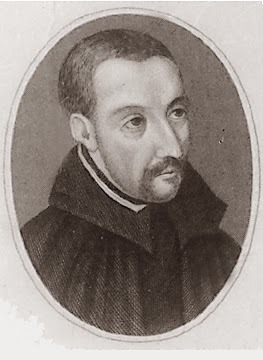 Here's an excellent overview from The Poetry Foundation of St. Robert Southwell's life and literary works --and his brave endurance and execution:
Here's an excellent overview from The Poetry Foundation of St. Robert Southwell's life and literary works --and his brave endurance and execution:Robert Southwell was born around 1561 at Horsham St. Faith, Norfolk, the youngest son and fifth child in a family of eight. The Southwells, a county family that had prospered from the dissolution of the monasteries, formed part of a network of wealthy, interrelated families that included the Wriothsleys, Howards, Bacons, and Cecils as well as recusants such as Vaux, Arden, and Copley. Southwell was a studious boy whose father liked to call him "Father Robert." In 1576 Southwell, like many other boys of his class, was sent overseas to be educated in the Jesuit school at Douai. He would not see England again for ten years. Between the ages of fifteen and seventeen he became convinced of his vocation to a religious life, and in 1578 he was admitted to the noviceship at Rome, where he embarked upon his formation as a Jesuit. In 1581 he transferred from the Roman to the English College, where he became tutor and perfect of studies. He was ordained in 1584 and was sent on the English mission in 1586, landing secretly with his fellow Jesuit Henry Garnet somewhere between Dover and Folkestone in early July. He was about twenty-five years old.
Christopher Devlin estimated a Catholic priest's chance of survival in England in 1586 as one in three. Southwell led the active but disguised and secret life of a pastor for six years, working mostly in and around London except for some journeys into the Midlands. For much of this period he lived under the protection of Anne, countess of Arundel, whose husband, the earl, was a prisoner in the Tower of London. In June 1592 the notorious priest hunter Richard Topcliffe succeeded in capturing Southwell. Topcliffe, Elizabeth I's servant and favorite, "an atrocious psychopath," in Geoffrey Hill's words, was allowed to torture prisoners in his own house. Southwell was in this man's hands and then in the hands of Privy Council interrogators and torturers for a month; news of his transfer to solitary confinement in the Tower was a relief to his friends.
After more than two years' imprisonment he was moved to the notorious cell in Newgate called Limbo, and his trial took place on 20 February 1595 under the statute of 1585, which had made it treason to be a Catholic priest and administer the sacraments in England. He was found guilty and was executed the next day by hanging, drawing, and quartering. At his trial Southwell said that he had been tortured ten times and would rather have endured ten executions. Pierre Janelle, who quotes the records in detail, writes that Southwell made of his trial and execution "a work of art of supreme beauty." He was thirty-three at his death. Pope Paul VI canonized him on 25 October 1970 as one of the Forty Martyrs of England and Wales.
Remember that I'll be on the Son Rise Morning Show, produced by Sacred Heart Radio for the EWTN Radio Network, around 7:45 a.m. Eastern/6:45 a.m. Central to discuss this great saint, poet, and martyr.
Published on February 20, 2014 23:00
Happy Birthday to Blessed John Henry Newman
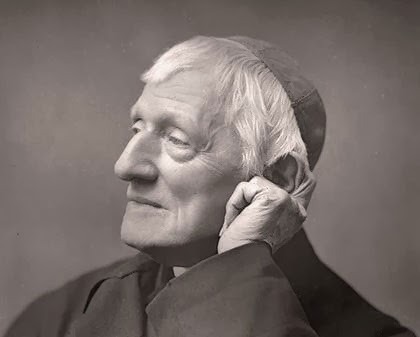 From Blessed John Paul II in 2001:
From Blessed John Paul II in 2001:On the occasion of the second centenary of the birth of the Venerable Servant of God John Henry Newman, I gladly join you, your Brother Bishops of England and Wales, the priests of the Birmingham Oratory and a host of voices throughout the world in praising God for the gift of the great English Cardinal and for his enduring witness.
As Newman pondered the mysterious divine plan unfolding in his own life, he came to a deep and abiding sense that "God has created me to do Him some definite service. He has committed some work to me which he has not committed to another. I have my mission" (Meditations and Devotions). How true that thought now appears as we consider his long life and the influence which he has had beyond death. He was born at a particular time – 21 February 1801; in a particular place – London; and to a particular family – the firstborn of John Newman and Jemima Fourdrinier. But the particular mission entrusted to him by God ensures that John Henry Newman belongs to every time and place and people.
Newman was born in troubled times which knew not only political and military upheaval but also turbulence of soul. Old certitudes were shaken, and believers were faced with the threat of rationalism on the one hand and fideism on the other. Rationalism brought with it a rejection of both authority and transcendence, while fideism turned from the challenges of history and the tasks of this world to a distorted dependence upon authority and the supernatural. In such a world, Newman came eventually to a remarkable synthesis of faith and reason which were for him "like two wings on which the human spirit rises to the contemplation of the truth" (Fides et Ratio,Introduction; cf. ibid., 74). It was the passionate contemplation of truth which also led him to a liberating acceptance of the authority which has its roots in Christ, and to the sense of the supernatural which opens the human mind and heart to the full range of possibilities revealed in Christ. "Lead kindly light amid the encircling gloom, lead Thou me on", Newman wrote in The Pillar of the Cloud; and for him Christ was the light at the heart of every kind of darkness. For his tomb he chose the inscription: Ex umbris et imaginibus in veritatem; and it was clear at the end of his life’s journey that Christ was the truth he had found.
But Newman’s search was shot through with pain. Once he had come to that unshakeable sense of the mission entrusted to him by God, he declared: "Therefore, I will trust Him... If I am in sickness, my sickness may serve Him, in perplexity, my perplexity may serve Him... He does nothing in vain... He may take away my friends. He may throw me among strangers. He may make me feel desolate, make my spirits sink, hide the future from me. Still, He knows what He is about" (Meditations and Devotions). All these trials he knew in his life; but rather than diminish or destroy him they paradoxically strengthened his faith in the God who had called him, and confirmed him in the conviction that God "does nothing in vain". In the end, therefore, what shines forth in Newman is the mystery of the Lord’s Cross: this was the heart of his mission, the absolute truth which he contemplated, the "kindly light" which led him on.
As we thank God for the gift of the Venerable John Henry Newman on the two hundredth anniversary of his birth, we pray that this sure and eloquent guide in our perplexity will also become for us in all our needs a powerful intercessor before the throne of grace. Let us pray that the time will soon come when the Church can officially and publicly proclaim the exemplary holiness of Cardinal John Henry Newman, one of the most distinguished and versatile champions of English spirituality. With my Apostolic Blessing.
From EWTN's Document Library.
Think of the passage of time since this was written! The author and the subject of the letter have both been beatified, and the recipient of the letter, Vincent Nichols then Archbishop of Birmingham now Archbishop of Westminster, will receive his red hat tomorrow on the Feast of The Chair of St. Peter the Apostle.
We will have to toast the Blessed John Henry Newman tonight at Eighth Day Books during our G.K. Chesterton meeting! I've already baked the cake and the champagne is in the fridge. We'll meet at 6:30 p.m.to discuss the first ten essays in The Thing by GKC.
Published on February 20, 2014 22:30
February 19, 2014
Other Publications Tab

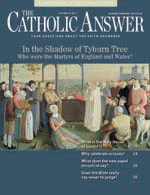

I have updated the Other Publications tab with new links to all the articles I've had published so far in OSV's The Catholic Answer Magazine. Editor Matthew Bunson told me that he'll be publishing another article he asked me to write in the March/April issue, and yet another in the May/June issue. OSV (Our Sunday Visitor) recently revamped their website and now allows visitors to see all content, regardless of print subscription. Dr. Bunson accepted another article recently, so I'll let you know when it will appear in print and on line. (The covers above are the issues when my article made the cover!)
Published on February 19, 2014 23:00
St. Robert Southwell on the Son Rise Morning Show
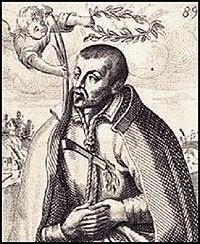 I'll be on the Son Rise Morning Show tomorrow morning to talk about one of the most amazing martyrs of the Forty Martyrs of England and Wales: St. Robert Southwell. This fine Jesuit poet and martyr endured tremendous tortures at the hands of Richard Topcliffe and then an execution that sickened the crowd so much that they would not allow the torture to continue. I've posted often about St. Robert Southwell, his poetry, his connections with St. Philip Howard and other figures of the English Mission--but I've never mentioned the family connection to the story of St. Thomas More.
I'll be on the Son Rise Morning Show tomorrow morning to talk about one of the most amazing martyrs of the Forty Martyrs of England and Wales: St. Robert Southwell. This fine Jesuit poet and martyr endured tremendous tortures at the hands of Richard Topcliffe and then an execution that sickened the crowd so much that they would not allow the torture to continue. I've posted often about St. Robert Southwell, his poetry, his connections with St. Philip Howard and other figures of the English Mission--but I've never mentioned the family connection to the story of St. Thomas More.St. Robert's grandfather, Sir Richard Southwell, was one of the survivors of the Tudor Dynasty, serving Henry VIII, being imprisoned for his Catholicism during the reign of Edward VI, serving Mary I, and finally being removed from Court--because of his Catholicism--early in the reign of Elizabeth I and dying very rich in 1564. His legitimized son Richard Southwell of Horsham St. Faith's, Norfolk was St. Robert Southwell's son.(Richard of Horsham St. Faith's mother was his father's second wife, but he was conceived while the elder Richard was married to another woman).
 The connection to St. Thomas More? Sir Richard Southwell was one of those the St. Thomas More's cell in the Tower of London taking away More's books and writing materials when Sir Richard Rich supposedly heard More condemn himself by speaking treason. Southwell denied having heard any of the conversation between More and Rich, being busy with the books, but the Court convicted More anyway. While Sir Richard Southwell was willing to benefit from the Dissolution of the Monasteries, at least he was unwilling to corroborate Sir Richard Rich's perjury.
The connection to St. Thomas More? Sir Richard Southwell was one of those the St. Thomas More's cell in the Tower of London taking away More's books and writing materials when Sir Richard Rich supposedly heard More condemn himself by speaking treason. Southwell denied having heard any of the conversation between More and Rich, being busy with the books, but the Court convicted More anyway. While Sir Richard Southwell was willing to benefit from the Dissolution of the Monasteries, at least he was unwilling to corroborate Sir Richard Rich's perjury.Sir Richard certainly participated in the fall and execution of Henry Howard, the Earl of Surrey, as he presented evidence about Surrey's addition of the arms of St. Edward the Confessor to his heraldic escutcheon--when such arms could only be displayed by the Prince of Wales. While no one could find the escutcheon when they searched for it, Southwell's word was enough to condemn Surrey for treason at the paranoid end of Henry VIII's reign. Surrey's execution and the imprisonment of Thomas Howard, the 3rd Duke of Norfolk were major blows to the Catholic coalition at Court, but Southwell shares more than a first name with Sir Richard Rich--an ability to advance by choosing the winning side in almost every conflict.
Matt Swaim, the new host of the Son Rise Morning Show, and I will discuss Sir Richard Southwell's grandson, the martyred saint, Robert Southwell, at 7:45 a.m. Eastern/6:45 a.m. Central tomorrow! Please listen live here!
Published on February 19, 2014 22:30
February 17, 2014
A Hidden Masterpiece on Display
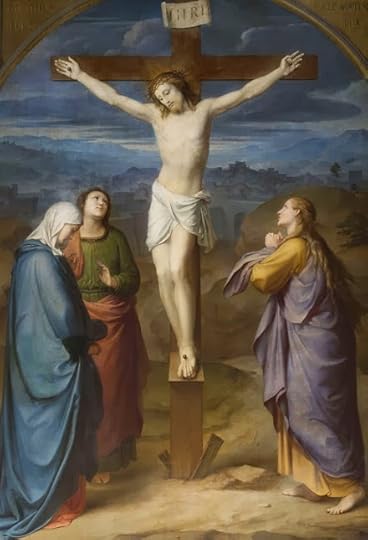
From UK's The Catholic Herald comes this story about Franz von Rohden's 1854 Crucifixion (pictured above; used by permission), which was in a closet at Ushaw College since sometime in the 1970's:
A painting that was kept in a closet at Ushaw College for 30 years and is hailed by scholars as a masterpiece has gone on display for the first time.
The work, by the German painter Franz von Rohden, was hung in a chapel at the junior college until the 1970s, when it was put in storage.
It was discovered following the closure of the seminary in 2011.
The painting had been commissioned in the 1850s by Mgr Charles Newsham, the president of Ushaw, who wanted it for private devotion.
On the advice of Cardinal Wiseman he had sought a painting from the Nazarene school – a group of German artists who moved to Rome to emulate pre-modern masters of the 15th century.
From the University of Durham website:
This exhibition focuses on a rare and largely neglected masterpiece by the Nazarene artist Franz von Rohden (1817-1903) currently preserved at Ushaw College. The painting, which depicts the Crucifixion of Our Lord with the Virgin Mary, St John and Mary Magdalene (1854), exemplifies the artistic creed of the Nazarene school of painting, founded in Rome by a group of dissident German artists in the early nineteenth century and characterised by the radical recourse to the pictorial repertoire of Italian pre-modern masters. While still relatively unknown in England today, the Nazarene movement exerted a tremendous influence on European Romanticism, the Gothic Revival and the British Pre-Raphaelites. . . .
The painting has never left Ushaw College and is here exhibited to the wider public for the first time. While still in progress in Rohden’s Roman atelier, this exquisite painting had already become a sensation. Its first admirers called it ‘a miracle of art and a most devotion-inspiring picture’ and elected it as ‘the finest picture of the subject that ever was painted’. The recourse to Nazarene art was suggested to Newsham by Ushaw’s most illustrious alumnus, Cardinal Nicholas Patrick Wiseman (1802-1865). The need to go to Rome, for the acquisition of artistic objects to adorn the college, coincided with the need to turn to the Holy See for the acquisition of sacred objects charged with a particular devotional energy. Nazarene artists, such as Rohden, suitably fulfilled this need.
More about the Nazarene Movement in religious art here. Rather like the naming of the Metaphysical Poets (per Samuel Johnson), the Nazarene name was given as a negative commentarty on their style.
Published on February 17, 2014 22:30
February 16, 2014
Heresy Without Orthodoxy: Ross Douthat's "Bad Religion"
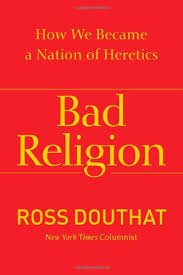 My husband and I visited our friendly neighborhood Eighth Day Books on Saturday and I purchased this book: Bad Religion: How We Became a Nation of Heretics. I am finding it fascinating reading. Heresies are essential topics in my study of Church History: the history of the Early Church can almost be seen as a struggle against heresy. As each heresy proposed a simple, logical way of understanding, for example, how Jesus was both God and Man, the bishops met at the councils and restated true Church teaching. The Arian heresy, particularly, divided the Church as St. Athanasius stood up against the world to defend the truth about Jesus. Sometimes we forget how cruel heresy can be (C. Fitzsimmons Allison wrote a book titled The Cruelty of Heresy: An Affirmation of Christian Orthodoxy that explored the more existential aspects of that cruelty), as the supporters of the heresy cast out the defenders of orthodoxy. I think we often view the orthodox as having all the power--but it isn't always so. I'll post a review in the next couple of days, but for now, here's a couple of notes: Douthat's thesis is that the problem is not that religion is on decline in the U.S.A., but that we have almost too much religion, and most of it is unorthodox. While so much of the popular religion is unorthodox, the orthodox religion--let's use C.S. Lewis' term, "Mere Christianity"--is not strong enough, persuasive enough or perhaps even confident enough to call people back to historical, doctrinal, sacramental, and more orthodoxy. Douthat starts his review of these issues with the post-World War II situation, examines the era when Reinhold Niebuhr, Billy Graham, Archbishop Fulton Sheen, and Martin Luther King, Jr. demonstrated the strengths of Mainline Protestantism, Evangelical Protestantism, Catholicism, and the African-American Church. He then looks at the period of accommodation, including the sad story of the decline of the Catholic Church in America after the Second Vatican Council--his narrative seems accurate enough to me. Philip Jenkins, Russell Shaw, and Al Kresta (I want to read his new book and Eighth Day should have it in stock by our G.K. Chesterton reading group meeting this Friday) have covered some of the same ground in different works, but Douthat is both persuasive and compelling in his view of the past almost 60 years.
My husband and I visited our friendly neighborhood Eighth Day Books on Saturday and I purchased this book: Bad Religion: How We Became a Nation of Heretics. I am finding it fascinating reading. Heresies are essential topics in my study of Church History: the history of the Early Church can almost be seen as a struggle against heresy. As each heresy proposed a simple, logical way of understanding, for example, how Jesus was both God and Man, the bishops met at the councils and restated true Church teaching. The Arian heresy, particularly, divided the Church as St. Athanasius stood up against the world to defend the truth about Jesus. Sometimes we forget how cruel heresy can be (C. Fitzsimmons Allison wrote a book titled The Cruelty of Heresy: An Affirmation of Christian Orthodoxy that explored the more existential aspects of that cruelty), as the supporters of the heresy cast out the defenders of orthodoxy. I think we often view the orthodox as having all the power--but it isn't always so. I'll post a review in the next couple of days, but for now, here's a couple of notes: Douthat's thesis is that the problem is not that religion is on decline in the U.S.A., but that we have almost too much religion, and most of it is unorthodox. While so much of the popular religion is unorthodox, the orthodox religion--let's use C.S. Lewis' term, "Mere Christianity"--is not strong enough, persuasive enough or perhaps even confident enough to call people back to historical, doctrinal, sacramental, and more orthodoxy. Douthat starts his review of these issues with the post-World War II situation, examines the era when Reinhold Niebuhr, Billy Graham, Archbishop Fulton Sheen, and Martin Luther King, Jr. demonstrated the strengths of Mainline Protestantism, Evangelical Protestantism, Catholicism, and the African-American Church. He then looks at the period of accommodation, including the sad story of the decline of the Catholic Church in America after the Second Vatican Council--his narrative seems accurate enough to me. Philip Jenkins, Russell Shaw, and Al Kresta (I want to read his new book and Eighth Day should have it in stock by our G.K. Chesterton reading group meeting this Friday) have covered some of the same ground in different works, but Douthat is both persuasive and compelling in his view of the past almost 60 years.
Published on February 16, 2014 22:30
February 14, 2014
Britain and the Holy See: 1982 to 2012

In 2012, Britain and the Holy See celebrated 30 years of uninterrupted diplomatic relations with a conference at the Venerable English College in Rome. According to a Catholic News Agency article at the time:
Today [March 30, 2012] the United Kingdom marked 30 years of full diplomatic relations with the Holy See with a one-day conference in Rome.
During his introductory remarks on March 30, U.K. Ambassador Nigel Baker called 1982 “a red-letter year in the relationship between Britain and the Holy See.”
The year “saw the establishment of bilateral diplomatic relations at ambassadorial level and the United Kingdom, for the first time, welcomed a reigning Pontiff – Blessed Pope John Paul II – to its shores.”
The day-long event, which was hosted by Rome’s Venerable English College, was titled “Britain and the Holy See: A Celebration of 1982 and the Wider Relationship.” With the assistance of numerous contributors, it attempted to review the events of 30 years ago and assess their historical, diplomatic and ecumenical impact.
Vatican Radio recently talked to Nigel Baker, the current U.K. ambassador to the Holy See, about the publication of the proceedings of that 2012 conference:
Celebrating Britain’s relations with the Holy See: that’s the goal of a glossy new publication bringing together contributions from Catholics and Anglicans, clerics and diplomats, professors, historians and ecumenical experts.
The book looks back to Pope John Paul II’s historical visit to Britain in 1982, as well as Pope Benedict’s state visit in 2010, tracing progress on both political and religious fronts. But it also recalls the darker days of division and alienation that lasted for four and a half centuries before John Paul’s groundbreaking pastoral visit.
To delve deeper into its pages and the story it tells, Philippa Hitchen sat down with Britain’s current representative to the Holy See, Ambassador Nigel Baker.
You may listen to the interview here.
As Ambassador Baker commented:
"During the colloquium I reminded people that this our oldest embassy, our embassy to the Holy See. The first resident British ambassador – English ambassador, at the time – was sent on mission in 1479 by King Edward IV. […] So when you get into context, talking about the Britain – Holy See relationship, you have to go back a long way in history and look at the impact of history, how we’ve got to where we are now.
"I think sometimes people can get confused. I always tell people I am accredited to the Holy See, which means the global Catholic network, the governance of the global Catholic Church. And I think people quite quickly realise that’s quite a different beast from a bilateral ambassador to, for example, the republic of Italy. In the colloquium and in the book we have presentations from two British cardinals, who remember the visit of Pope John Paul II vividly; we have Scottish, Welsh and English contributions; important contributions about the ecumenical relationship – both an Anglican bishop and an official of the Holy See talking about the relationship between Catholicism and Anglicanism. And I think all of these add to that complex mix which is the relationship between Britain and the Holy See, which goes far beyond the sometimes rather transactional relationship that ordinary bilateral relationships can be.”
Amazon.com has an entry for the booklet, but does not have it in stock! I am still searching.
Published on February 14, 2014 22:30
February 13, 2014
Charles I's Painter Looks Over His Shoulder
Richard Cork discusses Anthony Van Dyck's last "Self-Portrait" in The Wall Street Journal; he finds the artist concerned about his patron and his own health:
Van Dyck appears increasingly ill-at-ease, as if his fierce concentration on the task at hand has been diverted by some unexpected intrusion. He seems startled, and I can imagine him feeling annoyed by the disturbance. His mouth might be on the point of opening. A hint of a frown can be detected curving up from the edge of his raised right eyebrow.
What is really going on here? Van Dyck's last "Self-Portrait" may well reflect his gathering alarm about the state of his adopted home. Charles I, who contributed so greatly to Van Dyck's success, had alienated a growing number of powerful forces. And Van Dyck's eminent position within the royal court must have alerted him to the danger now confronting the monarch. (Civil war would break out in 1642.) Van Dyck was sensitive enough to appreciate the problem, and his anxiety could have been exacerbated by his own illness.
Van Dyck probably sensed, when he stared at his own reflection and set it down on canvas, that his health was ominously poor. In August 1641 the Countess of Roxburghe reported in a letter that he had been ill for a long time, and soon afterward Van Dyck grew so infirm that he abandoned a major commission to paint Cardinal Richelieu's portrait in Paris. He must have felt very frustrated, and at the base of the elaborate oak frame surrounding his last "Self-Portrait" a demonic face scowls as he opens his mouth in a roar of rage. There is certainly a haunting awareness of transience in the "Self-Portrait." Even as he emphasizes the strength of his penetrating gaze, Van Dyck conveys a melancholy awareness that nothing of him will endure very long, apart from the art he creates. The white shirt that occupies such a prominent space near the center of the painting looks as turbulent as a storm-stricken sea. This boldly handled passage of paint could almost be seen as prophetic, hinting at the military tempest that was about to engulf England and destroy the king along with so many of his subjects in a catastrophic conflict.
The National Portrait Gallery in London is raising funds to purchase, preserve, and display this portrait (and keep it from being obtained by a private collector). More about that effort here.
Van Dyck appears increasingly ill-at-ease, as if his fierce concentration on the task at hand has been diverted by some unexpected intrusion. He seems startled, and I can imagine him feeling annoyed by the disturbance. His mouth might be on the point of opening. A hint of a frown can be detected curving up from the edge of his raised right eyebrow.
What is really going on here? Van Dyck's last "Self-Portrait" may well reflect his gathering alarm about the state of his adopted home. Charles I, who contributed so greatly to Van Dyck's success, had alienated a growing number of powerful forces. And Van Dyck's eminent position within the royal court must have alerted him to the danger now confronting the monarch. (Civil war would break out in 1642.) Van Dyck was sensitive enough to appreciate the problem, and his anxiety could have been exacerbated by his own illness.
Van Dyck probably sensed, when he stared at his own reflection and set it down on canvas, that his health was ominously poor. In August 1641 the Countess of Roxburghe reported in a letter that he had been ill for a long time, and soon afterward Van Dyck grew so infirm that he abandoned a major commission to paint Cardinal Richelieu's portrait in Paris. He must have felt very frustrated, and at the base of the elaborate oak frame surrounding his last "Self-Portrait" a demonic face scowls as he opens his mouth in a roar of rage. There is certainly a haunting awareness of transience in the "Self-Portrait." Even as he emphasizes the strength of his penetrating gaze, Van Dyck conveys a melancholy awareness that nothing of him will endure very long, apart from the art he creates. The white shirt that occupies such a prominent space near the center of the painting looks as turbulent as a storm-stricken sea. This boldly handled passage of paint could almost be seen as prophetic, hinting at the military tempest that was about to engulf England and destroy the king along with so many of his subjects in a catastrophic conflict.
The National Portrait Gallery in London is raising funds to purchase, preserve, and display this portrait (and keep it from being obtained by a private collector). More about that effort here.
Published on February 13, 2014 22:30



